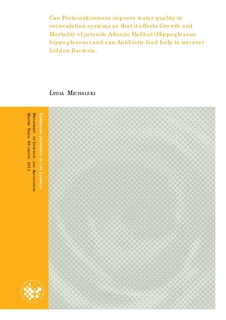| dc.description.abstract | In 2011 an experiment was done with juvenile Atlantic Halibut at the on-growing facility of Aga Halibut. Since 2004 the company recorded high mortalities and a low growth rate among the new delivered fish. The cause for that, however, was never specified even after various examinations. Due to that the experimental set up was much aligned, because there no useful indication existed that would have allowed a goal- orientated analysis. Therefore it was decided for a comparison in order to make statements on water quality and possible Bacteria or other microorganism infestation and thus narrowing down the problem.
In the experimental set up at the land-based facility, three different treatments where compared; proteinskimmed water with non – proteinskimmed water and regular feed with antibiotic feed. Overall this was compared to fish which had been directly set out into sea cages.
Regarding the results of the growth and mortality, all three different treatments were insignificant, neither the proteinskimmer nor the antibiotic feed gave any effect on lowering the amount of dead fish as well as any improvement of the growth rate. Only the peak of the mortality curve of the antibiotic feed treatment shifted for about two weeks, and the total mortality amount at the end was slightly lower compared to the other treatments. The results from the sea cage part could not be used, since organization problems prevented any outcome.
However all veterinarian reports plus water-, metal- and chemical analyses made during the years from 2004 until 2011 were collected and in addition all solution attempts were documented and together with the experimental results it was concluded that some form of hidden metal (copper) intoxification might be the reason behind the high mortalities and low growth rate. Hint to that was given by test of metals in 2007 and the fact that both propeller of the intake water pumps are made out of bronze, containing 80 to 90% copper. In addition up-coming results from a different facility were taken in consideration, confirming the idea of some basic problem within the plant itself.
But due to closing down the land-based facility and moving all the fish into the sea cages, it was not anymore possible to perform a second heavy metal test in order to be positive. | |
